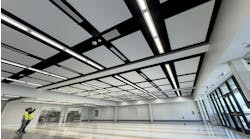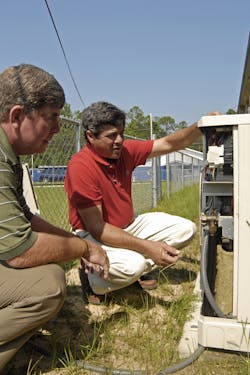Latest from Technology
Sponsored
Take a moment and imagine you are in your stockroom, taking inventory of your products. After going through each product, you begin to realize what you traditionally offer isn’t going to cut it anymore. Your customers are requesting the most-efficient technology available that will allow them to save on utility bills. You need to find a solution to retain and grow your business, and somehow your research leads you here. You might have heard of mini-split heat pumps, but how much do you actually know about the technology that is gaining more attention and market demand in the U.S. residential market?
Why should you and your customers consider investing in these systems? The mini-split developed its name from its split-system design, which consists of an indoor air handling unit connected to an outdoor unit. The term “mini,” reflects its small size in terms of footprint and load capacity. Mini-split systems can be ductless, ducted or both, and are commonly found in residential and light commercial projects. Typically, Europe and Asia dominate the market share for mini-splits, but as consumer demand increases and the industry shifts continually toward going green, they’ve grown from being a topic of discussion to being placed in homes across the U.S.
Now, you may be thinking, why are mini-split systems beneficial for business? Mini-splits are often the best money-making option for residential projects, but let’s break down this technology in terms of how it can help your business boom.
Energy efficiency is key
Over the past decade, there has been an increase in demand for HVAC product manufacturers to design and develop efficient products meeting government mandated ratings, called Seasonal Energy Efficiency Ratings (SEER). The government enforced the latest SEER standards in 2015, and now requires heat pumps installed on or after Jan. 1, 2015, must achieve the minimum rating of 14 SEER in most areas of the country, according to the U.S. Department of Energy. However, some manufacturers, like Mitsubishi Electric Cooling & Heating (Mitsubishi Electric), have developed efficient mini-split systems reaching SEER ratings in the low-to-mid 30s — as you are aware, the higher the SEER, the better the efficiencies.
How do mini-splits meet this efficiency demand? Well, unlike traditional systems, ductless mini-split heat pumps do not push air through ducts. Instead, the indoor unit is coupled to an outdoor unit by small refrigerant piping and electrical wiring. Because the compressor is inverter-driven rather than fixed speed, it typically runs at a low frequency to maintain the desired temperature and only increases to quickly cool or heat a space.
Utility bill savings outweigh initial expenses
Mini-splits may have higher initial costs than traditional systems, but the upfront costs are justified by a mini-splits’ reduced lifetime costs — their installation and operational costs are often lower as well. Installation costs are reduced because mini-splits offer a simpler installation process than conventional systems, saving on materials and labor. Because of the mini-splits efficiency, overall operational costs are reduced. Thanks to that ingenious inverter-driven compressor, users can expect to see a savings of up to 40 percent a year on energy with a Mitsubishi Electric system, as compared to traditional systems. Over a product’s life cycle, these benefits add up — ultimately making the case that mini-splits are a superior financial choice compared to other options currently available.
Making your job easier
When recommending a system to a potential customer, you’re going to get the typical question, “How long will it take to install?” It’s not an uncommon question at all. According the U.S. Energy Information Administration’s (EIA) Residential Energy Consumption Survey (RECS), around 44 percent of homeowners in the U.S. never turn off their air conditioning during the summer months. While a whole home installation may take longer to complete, individual rooms or spaces can be installed and functional in the same day. This provides some relief for air-conditioning addicts.
These systems are not only versatile for the homeowner to personalize, but also versatile for the HVAC contractor to specify.
How is that possible? One of the many installation benefits of mini-splits is the simplicity of the unit. The two-component set-up is made up of an indoor unit, mounted to an interior wall and connected to the outdoor unit by two refrigerant lines that pass through a small penetration (three inches or fewer in diameter). Due to their split-system design, alongside the minimal-to-no ductwork involved, mini-split systems can require no demolition to install — perfect for renovating a house that was built before air conditioning was available as well as new construction projects. Minimal piping and a small footprint mean lower equipment costs and a faster installation in terms of labor.
Personalized comfort for your customers
For the last few decades, mini-split technology has been known as a smart solution for providing spot cooling and heating for spaces where installing a conventional system would be costly or even impossible. In recent years, as some manufacturers have introduced extremely versatile indoor styles like multi-position ducted indoor units, mini-splits have become a desired system for the whole home.
Because mini-split units are also small by nature, they can easily fit in tight spaces. Since they can be ducted, ductless or both, homeowners can select which indoor units best fits their space and style. For example, with Mitsubishi Electric’s Designer EF-series wall-mounted indoor units, homeowners can choose whether they want the unit to blend or stand out. The unit can also be mounted in any space. Mini-split design flexibility does not stop at a wall-mounted indoor unit, though — Mitsubishi Electric also offers floor-mounted indoor units, multi-position ducted indoor units, ceiling-concealed ducted units, ceiling-suspended units and ceiling-recessed units.
These systems are not only versatile for the homeowner to personalize, but also versatile for the HVAC contractor to specify. Mitsubishi Electric systems have a capacity range between 2,800 - 42,000 BTUs, offering contractors more options when specifying homes. Because of the flexibility of Mitsubishi Electric’s systems, HVAC contractors can design any given system in a variety of ways, whether seeking to maximize comfort, efficiency or upfront cost savings. For example, if a homeowner wants seven zones, that can be accomplished one of several ways, including one multi-zone outdoor unit connected to seven indoor units or seven single-zone outdoor units each connected to one indoor unit. Each option offers something, in this case the former offers upfront cost savings whereas the latter offers ultimate efficiency. Having such flexibility ensures contractors can offer homeowners personalized systems that speak to their individual wants and needs.
Smooth operator
Mini-split technology has a much quieter system compared to traditional systems. The outdoor units feature efficient DC motors and fan blades designed to minimize the noise many central systems make. Further, the compressor is housed in its own insulated compartment and sits on rubber feet for maximum vibration dampening. The indoor units are also incredibly quiet. The small, compact footprint and specially designed fans deliver extremely quiet and powerful, consistent airflow. Ductless and short-run ducted units operate at barely detectable sound levels, which mean some indoor units are even quieter than a human whisper.
Support from manufacturers
Although the installation of mini-split systems is described as simple, it does require aMitsubishi Electric has mobile applications to assist contractors in the selling and installation processes. Rather than an HVAC contractor walking into a house and specifying a system based on the number of bedrooms and the home’s geographic location, Mitsubishi Electric’s Residential Home Builder application allows the contractor to take it one step further and essentially design the optimal system for any given house. This application provides the homeowner with a more accurate estimate of the size and type of system that should be used, providing the homeowner options upfront.
It’s time to take advantage of this technology
While residential HVAC contractors are still installing other cooling and heating systems, the mini-split is an adaptable product that’s on the rise to dominate the U.S. market. Over the past two years, the U.S. mini-split market has already grown by 13 percent and will continue to increase over the next decade, according to “A Look at Ductless Growth in North America” by North America Equity Research, J.P. Morgan.
This technology is a leader in the HVAC category because of its impressive efficiency ratings and ability to provide personalized comfort. As more and more customers ask for these benefits, there is an opportunity for HVAC contractors to meet those demands through stocking and installing mini-split systems. Contractors have the opportunity not to just offer the products, but become true experts in the technology and participate in rewarding manufacturer programs. By doing so, they will grow their business successfully.
Michelle Robb is Director, Residential Marketing for Mitsubishi Electric US, Inc. Cooling & Heating Division. In this role, she leads the marketing strategies, programs and initiatives for the division’s residential product line. Robb has over ten years of product planning and marketing experience in the HVAC industry.




